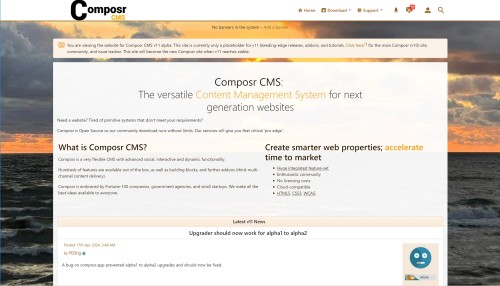Contributors: A-Z Index
A
| Name | Photograph | Title / Role | Contributions / Notes | |
|---|---|---|---|---|
| Allen Ellis |

|
Founder |
Original designer for ocPortal Also conceived and coded the Theme Wizard and Point Store Son of one of the early inventors of Internet protocols (Usenet, aka Internet newsgroups) Token non-brit |
View |
C
| Name | Photograph | Title / Role | Contributions / Notes | |
|---|---|---|---|---|
| Chris Graham |

|
Founder |
Original developer of ocPortal, former lead developer of Composr CMS Masters degree in Computer Science from The University Of Sheffield Undertaken work for over 15 FTSE-100 companies, as well as many small and mid-sized organisations. Includes a number of banks and major brands. |
View |
| Chris Warburton | developer for ocProducts |
Made some key contributions to ocPortal |
View |
H
| Name | Photograph | Title / Role | Contributions / Notes | |
|---|---|---|---|---|
| Haydn Maidment | project manager for ocProducts |
None available |
View |
J
| Name | Photograph | Title / Role | Contributions / Notes | |
|---|---|---|---|---|
| Jim Davidson | contributor |
written many tutorials via Arvixe |
View |
P
| Name | Photograph | Title / Role | Contributions / Notes | |
|---|---|---|---|---|
| Patrick Schmalstig |

|
Lead Developer |
Joined Chris Graham behind the scenes in the development of Composr CMS in 2016. Took on the lead developer role in 2023 when Chris Graham stepped back to attend to his new lifestyle changes. Spearheaded the development of Composr CMS v11 and the new website, Composr.app. Formed the company PDStig, LLC to take on professional support and development for Composr CMS users especially after the discontinuation of ocProducts, Ltd. |
View |
| Philip Withnall | Early Developer |
Coded the chatroom, blogging support, the analytics system, and OcCLE (now Commandr) Masters Degree in Computer Science degree from The University Of Cambridge Other work has included helping out with Firefox, and ongoing work on GNOME |
View |
R
| Name | Photograph | Title / Role | Contributions / Notes | |
|---|---|---|---|---|
| Robert Goacher |

|
Founder |
Ran some of the early websites where ocPortal came from Technically the original developer of ocPortal, in that he wrote the first few lines of code Heavily involved in the feature design process Hosted some of our early meet-ups |
View |
S
| Name | Photograph | Title / Role | Contributions / Notes | |
|---|---|---|---|---|
| Steve Jarvis | project manager for ocProducts |
Wrote many tutorials via Arvixe |
View |
Newest 10 Entries
| Name | Robert Goacher |
|---|---|
| Photograph |  |
| Title / Role | Founder |
| Contributions / Notes | Ran some of the early websites where ocPortal came from Technically the original developer of ocPortal, in that he wrote the first few lines of code Heavily involved in the feature design process Hosted some of our early meet-ups |
| Name | Chris Graham |
|---|---|
| Photograph |  |
| Title / Role | Founder |
| Contributions / Notes | Original developer of ocPortal, former lead developer of Composr CMS Masters degree in Computer Science from The University Of Sheffield Undertaken work for over 15 FTSE-100 companies, as well as many small and mid-sized organisations. Includes a number of banks and major brands. |
| Links |
| Website | Earth & Sky |
|---|---|
| Screenshot |  |
| Short Description | Earth & Sky is a Composr v11 gallery website showcasing natural photography by Mark Brunner. |
| Website | Saving Wallden |
|---|---|
| Screenshot |  |
| Short Description | This is an informational website for a Visual Pinball X game in development called "Saving Wallden". The site features the planned game rules, development news, and a download of the game as it is so far. |
| Website | PDStig, LLC |
|---|---|
| Screenshot |  |
| Short Description | This is an informational site / portfolio for PDStig, LLC, the company run by one of Composr's lead developers, Patrick Schmalstig. |
| Website | Composr CMS: Content management meets social media |
|---|---|
| Screenshot |  |
| Short Description | This is the main website for Composr CMS version 11. It runs the latest build of v11. Currently it is just a placeholder but will soon replace compo.sr when v11 becomes stable. |
| Question | Should I use the bleeding edge releases or the git repository? | ||||||||||||||
|---|---|---|---|---|---|---|---|---|---|---|---|---|---|---|---|
| Answer | That depends on several factors. Here are some pros and cons of each:
Click here to access the git repository. |
| Question | Can I switch a v11 install from git over to using the releases from composr.app? |
|---|---|
| Answer | It is not recommended you do this because you may run into issues. For example, some changes were made in crypto_master.php and data/upgrader2.php prior to the first v11 alpha. These changes will result in a broken upgrade unless you already pulled these changes from git. Similar situations could happen in the future as well. It is recommended you either discard the git install and use a fresh install from the Downloads, or to maintain a git install and a bleeding-edge release install separately. Do not combine the two. |
| Question | Should I update my non-bundled addons after updating to a newer release of version 11? |
|---|---|
| Answer | Absolutely! Frequent changes may be made to both bundled and non-bundled addons. Bundled addons will be updated via the upgrader. For non-bundled addons, you will have to update them through the addons management screen (Admin Zone > Structure > Addons). You will be informed which ones need updated. Once version 11 reaches release candidate, we do not expect frequent updates to non-bundled addons anymore. But it is still good practice to check after every update. |
| Question | Can I upgrade a version 10 site to version 11? |
|---|---|
| Answer | Yes, for basic non-custom v10 sites. However, expect some issues to arise in the process. And please report those issues to the tracker. For v10 sites with non-bundled addons or customisations, upgrading to v11 will likely break the site until you update the non-bundled addons or temporarily remove the customisations. We aim to have the upgrader fully functional for a large majority of types of sites and for sites using non-bundled addons by the time version 11 reaches release candidate stage. We do not recommend upgrading production v10 sites at this time until v11 reaches stable. |
Top 10 Entries
| Question | Why does Composr use pre-computed statistics? |
|---|---|
| Answer | Composr generates statistics from pre-computed data for several reasons:
|
| Question | What are KPIs and how are they used in Composr? |
|---|---|
| Answer | KPIs (Key Performance Indicators) are specific measurements selected for marketing analysis. In Composr, time-series graphs can be added as KPIs. They offer several benefits:
|
| Question | How can I perform split testing in Composr? |
|---|---|
| Answer | Split testing in Composr involves combining tracking codes with events. The simplest approach utilizes Tempcode:
|
| Question | What is the purpose of tracking codes in Composr? |
|---|---|
| Answer | Tracking codes help you identify the sources driving user sessions to your website or associate specific split testing variations with users. Composr offers integrated referral tracking through various means:
|
| Question | What are the different ways to track events in Composr? |
|---|---|
| Answer | Composr offers various methods for tracking events:
The JavaScript and HTML data attribute methods can also be integrated with Google Analytics events. |
| Question | How do I install geo-location data for Composr statistics? |
|---|---|
| Answer | Geo-location data installation is usually automatic during the Composr installation process. If not, you can manually install it by navigating to Admin Zone > Audit > Site statistics > Install geolocation data. This action will reschedule the installation task. If you don't see this option, the geo-location data is already installed. |
| Question | What are the key differences between Google Analytics and Composr statistics? |
|---|---|
| Answer | While there is some overlap, Composr statistics and Google Analytics are complementary tools. Google Analytics Pros:
Google Analytics Cons:
Composr Statistics Pros:
Basic users may find Composr statistics sufficient, while expert marketers might prefer the power of Google Analytics. |
| Question | What tools and strategies can be used for staff training and development? |
|---|---|
| Answer | While Composr itself doesn't provide built-in training features, several approaches can be used for staff development:
By investing in ongoing staff training and development, communities can ensure their teams possess the necessary knowledge and skills to perform their roles effectively and contribute to the platform's overall success. |
| Question | How can potential conflicts between staff members be avoided (regarding content moderation)? |
|---|---|
| Answer | Composr incorporates "conflict detection" features to prevent staff from accidentally overwriting each other's work. When multiple staff members attempt to edit the same resource simultaneously, a warning message appears, prompting communication and coordination. Open communication and transparency are crucial. Encourage staff to share their ongoing tasks and plans with each other to prevent overlaps and potential conflicts. Utilizing shared tools like the staff checklist and private forums can further facilitate coordination. |
| Question | What should be considered when assigning roles and responsibilities to staff? |
|---|---|
| Answer | When assigning roles, it's recommended to start new staff with limited responsibilities and gradually increase their authority based on performance and dedication. This fosters a sense of progression and prevents discouragement among existing staff. Always consider the individual's skills and interests when assigning tasks. For example, someone with strong writing skills might be well-suited for managing content creation, while a technically-minded person could excel at site maintenance. |

